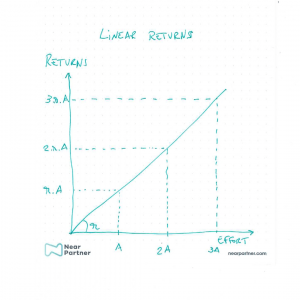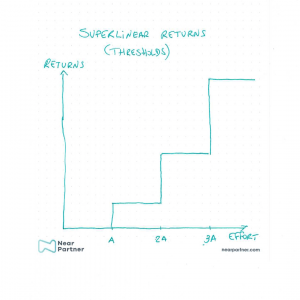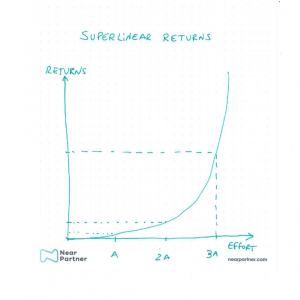A challenging concept you need to understand
This concept was explained very recently by Paul Graham.
There is a particularly important concept which is very seldom talked about. However, understanding it is hugely correlated with our success, whether professionally, personally, as individuals or as companies and organizations – it is the idea of Superlinear Returns.
I will define what superlinear returns are in a minute, but, beforehand, it is important to know that, although the concept is easy to understand it is not intuitive to put into practice because we were led to believe that the world works exactly the other way around. Given that, I will ask for your patience to indulge me with an explanation.
But what are superlinear returns and how does it compare to linear returns?
We are led to believe that, regarding most of the things in the world, what you get is proportional to what you put in. Let us call to what you put in “effort.” It might be time spent, hard work, dedication, or any other use of energy.
So, what you come to believe, when you are a child, is that if you participate in all the training practices, you will eventually be selected for the first team. Or that if you apply some effort during classes, you will learn something. But, if you try a little bit harder, you will learn a little bit more. These are examples of linear returns. And although these are not explicitly stated like this, it has been made implicit that this is how it works.
This is not true. As life goes on you come to realize that most of the time, if you are almost as good as the kid you are playing against, you will almost always lose! At least in sports, most of the time, the winner takes it all. I would say that is usually the first experience when we understand that returns are not linear.
A universal experience of superlinear return
Most of us were exposed to the most ubiquitous experience of superlinear returns. I am talking about learning. Learning is one of those cases where how much you learn is directly related to how much you have learned so far. This seems like a remarkably simple proposition, but what it means is that learning grows exponentially. Just think about it for a moment. It is startling! But we go through it without explicitly understanding it.
Everybody gets surprised by the story of the pastor who won a chess match against his king and asked for a chessboard of grains of rice placed upon each square such that one grain was placed on the first square, two on the second, four on the third, and so on (doubling the number of grains on each subsequent square).
The result amounts to more than 18 quintillion grains of rice (more than 18 million of millions of millions or more than 18.4 x 1018).
Going back to learning, the example is easy to understand. You go to primary school and learn the numbers. That is simple, but learning the numbers allows you to count, and measure. Pretty cool. But then you can learn to sum, subtract, and multiply. And from there you can learn everything algebra gives. And because of that, you can learn physics. Or complicated mathematical operations. And so, how much you have already learned compounds to the new fields you can now learn.
But there is more. There are the practical uses of what you learned and how that allows you to learn more. To begin with, the more you learn, the more the teachers will push you to learn and so… the more you have learned so far, the more you will learn. Also, how much you have already learned will allow you to move into better schools, with better teachers and the machine will keep working like this. On and on.
Learning compounds. Like the interest rates of an investment.
This has been, since ancient times, one of the biggest causes of inequality. That is why people still talk about the social elevator being powered through education. It is because of how much further away one finds himself if he is “caught” on this compounding machine of learning.
In business you may find that if you are selling lemonade, and your lemons are a little bit better than those of all the competition, you will have an advantage which is not proportional to how much better your lemons are. You will be able to sell all your lemonade at a higher price than all the competition.
This means we can summarize the situations as Linear and Superlinear Returns. And the Superlinear Returns will, most of the time, be in an exponential (like learning) or in a threshold (like the lemonade example) situation.
So far so good.
But why is this important? Is this just theoretical? No, it is not.
To begin with, because by understanding the concept you can use it in your favor and improve your odds. It becomes clear that “learning machines” will have an edge and will always win. This is because if you can learn at a greater rate, you will know more (exponentially more) than your peers. But as companies and organizations it is also important to understand how you can beat the competition. The landscape is not linear. Success is not linear.
As Paul Graham puts it, if you do exceptional work, you will probably crush it! On the one hand there is much less competition there, as we saw above, if you pushed yourself (individually or as a company) ahead of the crowd, you will be exponentially more knowledgeable. Most people will be afraid to even get a shot at excellence, so you will find a very solitary playground, just for you.
A few weeks ago, we published a post with some of the challenges we have identified for 2024. The ones who will be better able to tackle these will have to stack superlinear returns in their favor.
A philosophical reflection on superlinear returns
Philosophically, there is another reason why the concept is important. As we live in an age of despair, the superlinear returns concept is important to understand, because it gives you a clearer view of the World. When we look into the news, we come with a depressing idea that the World is going bonkers, and that humanity as such is probably doomed. As the author Steve Pinker puts it the World is “bad but better”.”
In his multi-awarded book “Sapiens,” Harari remembered us that for the first time in the world: there are more people dying from self-inflicted wounds than from being murdered (including in wars); there are more people suffering from obesity than from malnutrition in the world; there are more people dying today from old age diseases than infectious diseases.
The reality is that much of the improvement that we can detect (although sometimes we do not feel it) is based on a superlinear return. For instance, world health has been improving for a few centuries now. But the fact is that the rate of improvement has been accelerating. Although how and why goes beyond the topic of this article, it would be important to understand it if we are making global decisions about where and when to invest. As electors we are often being called to voice our opinion about these matters.
For all the reasons above, I think this concept to be mind-blowing. The thing is, if you are like me, you understood the concept a long time ago, but it is challenging making it explicit. However, it must be clear for one to build on it. We need it clearly stated, before we can begin to use it. In our everyday life; in our professional work; in our companies; and as citizens.
– “If you’re not learning, you’re probably not on a path that leads to superlinear returns”, Paul Graham;
Never miss a beat! Subscribe to our newsletter for a front-row seat to great content.








